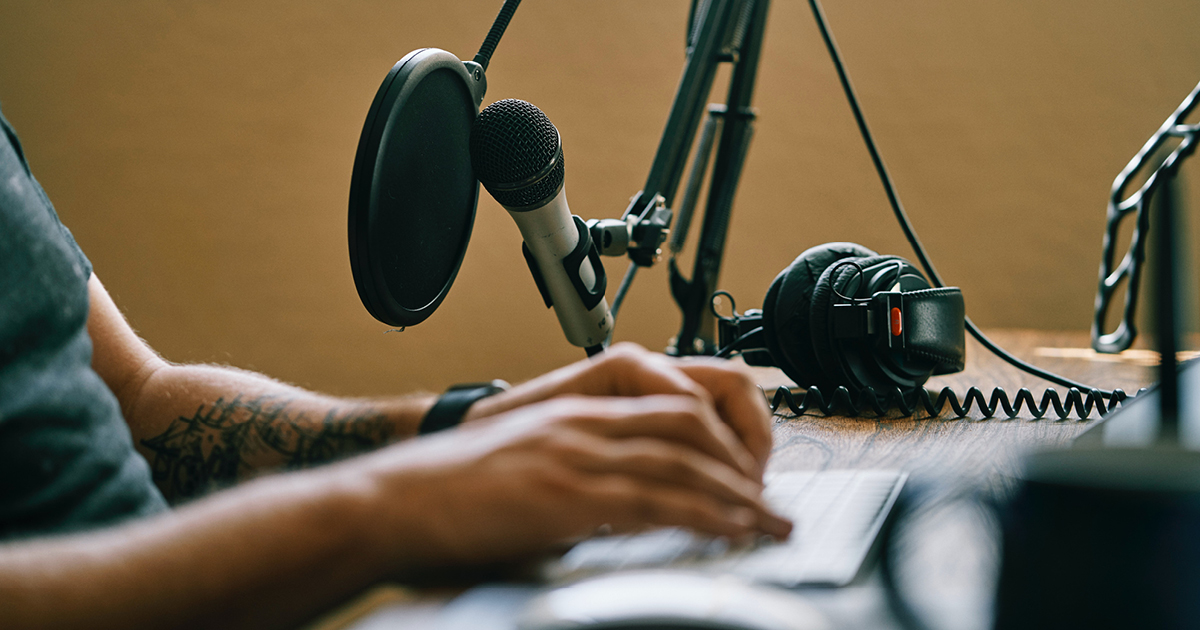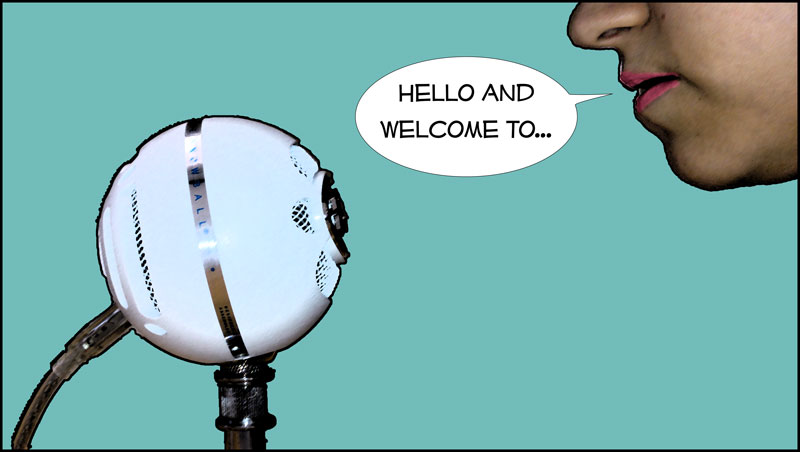Did you know that by the end of 2019 there were 800,000 active podcasts? That means there were 800,000 series out there that sounded significantly better than your average B2B podcast.
In my eight years of writing B2B copy, I’ve listened to (and occasionally scripted) a fair few podcasts – from small business efforts to audio exploits from the largest enterprises. And after eight years of Radix podcasts, it’s a subject we get asked about a lot.
After hearing the good, the bad, and the very distorted, my key takeaway is this: if you can spare the time and budget to attract some of the brightest minds in your industry to speak on your podcast, you can afford to use a microphone that doesn’t make them sound like they’re screaming through sandpaper.
Want some more specific (and slightly less inflammatory) advice to give your next podcast an audio boost? Then look no further than this essential audio kit list for B2B podcasts.
Microphones
This is the big ticket to clear-audio-town, but the breadth of different microphones and price points means I’ll be splitting this out into different sections to suit different budgets.
The cheap and cheerful
Not everyone has the budget to justify a microphone that will capture the full timbre of the human vocal cords. But spending even a little will get you a lot compared to the very shaky microphones built into most laptops.
If you have absolutely zero budget for audio equipment: consider recording on a phone (and asking any speakers recording remotely to do the same). As phones are designed around talking, they tend to have better built-in microphones than the average laptop.
If you have a small budget that needs to go far: look at getting basic headsets for each participant. With some well-reviewed options costing as little as £25, there’s little reason to feel tied to your laptop mic. While headsets don’t always have the clearest microphones, they do solve audio spill issues and echo problems you often hear when people record themselves through laptop speakers and mics.
The premium experience
If you can stretch your budget further, you open the door to much better microphones.
There are as many mics out there as there are businesses trying their hands at podcasts, so it helps to narrow down the two most common categories of microphones:
Dynamic microphones are often cheaper and have low sensitivity. That means they don’t always sound as crisp and clear as other mics, but they don’t pick up much background noise either. They’re ideal for recording in potentially noisy environments, or for those trying to keep budgets low.
Condenser microphones are more sensitive and capture more of your speaker’s voice. In short, they’ll sound less compressed, clearer and more natural than other kinds of microphone. However, this sensitivity can be a double-edged sword if you’re trying to record lots of people or in a noisy area – condenser mics pick up everything.
An important consideration between the two is the need for phantom power (sounds metal as hell, I know). Dynamic mics don’t need any power to work – so if you can plug them into your audio kit, you’ll be good to go.
Condenser microphones need additional power, so they must be connected to an interface that can supply phantom power. They also need a special connection to get that power, so you’ll need XLR inputs (the one with three prongs) rather than a conventional ¼-inch jack connector. If you aren’t sure which ports you have available, look up the specs of your audio interface and double check before buying a condenser mic.
Pop shields
If you’re using a phone or headset, then unfortunately you just have to live with pop sounds whenever you say a word with a ‘b’ or ‘p’ in it. But if you’re using a standalone microphone, pop shields can help smooth out plosive syllables.
This may seem like an extravagant item, but they’re cheap enough that they’re well worth the expense (they’re often no more than the price of a cup of coffee or two). If you really don’t want to spend any money, or if you want to try before you buy, you can even make your own pop shield – though it might not look especially professional.
Mixing software/hardware
At some point, you need either a piece of software or hardware that can take the audio from your different hosts and experts, mix it so everything sounds OK, then spit it out into a digital file ready for your platform of choice.
Because of the sheer variety of different approaches you can take for your setup, I can’t offer definitive advice on exactly what to buy; it will very much depend on your needs and situation. But I can give you general things to look out for.
There are two kinds of interfaces you’ll come across:
- All-in-one recorders
These tend to pull all the audio in and have you mix it together directly on a dedicated piece of hardware (kind of like a big tape deck with a few faders stuck on the front). Once you’re happy with it, the device creates an audio file on an SD card that you can then transfer to your computer. - Digital interfaces that connect to software
An interface acts more like a set of ports to feed audio from your mic through to a computer running Digital Audio Workstation (DAW) software like Pro Tools, Logic or GarageBand. You then mix and process the audio through the software before turning it into a more conventional audio file that you send to a podcast hosting site. Or, your interface could connect to dedicated podcast recording software like Anchor or Squadcast.
Is one approach better than the other for recording a podcast? Not really. Using a DAW is arguably more flexible than hardware options or a podcast recording app, but it’s also more complicated – and arguably overkill for something straightforward like recording a few people talking.
And while Squadcast et al. offer a really easy way to record remote speakers, they won’t be much help if you want to pivot to other types of audio content like live webinars.
Whatever direction you decide to go in, here’s a few things to think about:
- Ease of use – dedicated recording devices tend to just work. There are no plugins to consider, or audio interfaces that need configuring and integrating.
- Flexibility – DAWs offer maximum flexibility, as you can download new extras as needed. Want to start compressing speaker audio? You can download the right compression plugins and you’re done – whereas with dedicated hardware or podcast software, you’re stuck with what’s there by default.
- Editing needs – with a DAW, it’s easy to see the audio waveforms and edit them on-screen, which really helps if you need to merge takes together or cut out any flubbed lines. You can edit audio on many dedicated recorders, but it’s often a bit more challenging than on a DAW.
- Collaboration – if you’re planning to work on podcasts together with other people, or send audio files to a sound engineer, audio software is a bit more forgiving here. Popular software like Logic and Pro Tools are considered industry standard, so if you start sending their file formats around, you’re likely to stay on the good side of your local audio gurus. Meanwhile, the likes of Anchor and Squadcast make it easy to record together remotely.
Some recommendations to get you started
While I can’t give you an exact list of what to buy for your specific audio needs and situation, I can point you in the right direction with a few well-regarded bits of equipment.
For dedicated recording hardware units, there’s this delightful digital recorder that’s a staple of team Radix’s podcast recordings (at least, when we’re in the office). Or, if you’re planning on only using dynamic microphones (the ones without phantom power), you could grab this budget-friendly 6-track Tascam.
As for a DAW software and interface combo, there’s a few easy options to recommend. For your interface, the Audient iD4 offers fantastic value for money for recording one voice over at a time. And if you need to record multiple microphones at once, this four-input delight from Behringer is a hit with recording bands and podcast teams alike.
As for audio software, you have a few different options depending on what operating system you use. If you’re using a Mac to record your audio, you can opt for GarageBand: a free, yet surprisingly powerful Mac-exclusive app. Apple fans can also use Logic Pro, which isn’t free but is widely loved by recording gurus the world over.
Whether you’re on Mac or PC, you can’t go too wrong with Pro Tools. It’s considered the industry standard DAW for a reason. Or, those looking for a cost-effective, customisable bit of kit would also be served well by Reaper. Don’t let the cheap licensing fee fool you, Reaper is a massively capable bit of software that’s quickly gaining traction with some of the best and brightest audio engineers out there.
On the podcast-specific side, Squadcast offers an easy way to record different experts or guest hosts remotely. Similar to Zoom or Teams, it lets remote speakers dial in to a call easily, but it records audio locally to each user rather than on the call itself – so you won’t get horrid audio issues from anyone with a slow connection.
In short: keep it simple and only get what you need
There’s a lot of audio equipment out there, and much of it is overspecced (and overpriced) for recording a podcast.
If you’re finding yourself overwhelmed by the choices available, remember these four tips:
- Focus on getting nice microphones. That’s where audio quality starts, so it pays to focus your efforts – and your budget – here.
- Get yourself a pop shield, preferably one for every speaker. Or, if you’re really tied for budget, make them yourself.
- Think carefully about whether you use software or dedicated hardware. Depending on how much control you need, and how many remote guests you want to record, some options will more suitable than others.
- When deciding on a recording interface, think about inputs. Effects, pre-amp quality and the like are nice, but not essential. Just make sure your kit of choice has the right type of inputs (and possibly phantom power) for your microphones, and has enough of them.
If you want to hear an example of this kind of simple but mighty audio equipment in practice, look no further than our very own Radix podcast. You’ll be able to hear how we handle recording our own hosts, and capturing audio from experts recording remotely. And you might even pick up some B2B content marketing and copywriting tips along the way.


